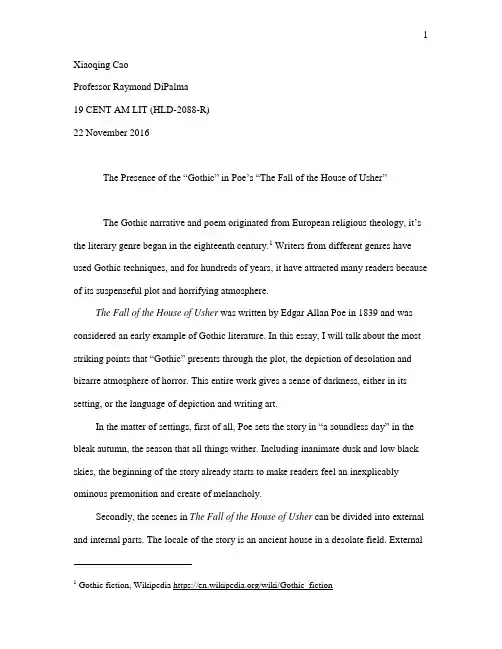爱伦坡及其作品中的哥特式元素
- 格式:doc
- 大小:139.00 KB
- 文档页数:13

Xiaoqing CaoProfessor Raymond DiPalma19 CENT AM LIT (HLD-2088-R)22 November 2016The Presence of the “Gothic” in Poe’s “The Fall of the House of Usher”The Gothic narrative and poem originated from European religious theology, it’s the literary genre began in the eighteenth century.1Writers from different genres have used Gothic techniques,and for hundreds of years,it have attracted many readers because of its suspenseful plotand horrifying atmosphere.The Fall of the House of Usher was written by Edgar Allan Poe in 1839 and was considered an early example of Gothic literature. In this essay, I will talk about the most striking points that“Gothic” presents through the plot, the depiction of desolation and bizarre atmosphere of horror. This entire work gives a sense of darkness, either in its setting, or the language of depiction and writing art.In the matter of settings, first of all, Poe sets the story in “a soundless day” in the bleak autumn, the season that all things wither. Including inanimate dusk and low black skies, the beginning of the story already starts to make readers feel an inexplicably ominous premonition and create of melancholy.1 Gothic fiction, Wikipedia https:///wiki/Gothic_fictionSecondly, the scenes in The Fall of the House of Usher can be divided into external and internal parts. The locale of the story is an ancient house in a desolate field. External refers to the environment: “I looked upon the scene before me —upon the mere house, and the simple landscape features of the domain —upon the bleak walls —upon the vacant eye-like windows —upon a few rank sedges —and upon a few white trunks of decayed trees…” This plain environmental description obviously reflects the author’s own sensitivity, so that even as a reader, I have been infected with the dreariness.“The room in which I found myself was very large and lofty. The windows were long, narrow, and pointed, and at so vast a distance from the black oaken floor as to be altogether inaccessible from within.” These words describe a gloomy and dim atmosphereinside the house as well, and I associate the images with the horrible and strange things that might happen there.The third crucial point in the settings is the same mental confusion, which is varying degrees of insanity that three characters in the story all have: Roderick, narrator’s friend, seems to be aware of his mental abnormality and tries to regain consciousness, which can be seen in “The writer spoke of acute bodily illness …—and of an earnest desire to see me, …by the cheerfulness of my society, some alleviation of his malady.”Madeline, his sister, has accepted her mental problems and continues to lives on, “Hitherto she had steadily borne up against the pressure of her malady, and had not betaken herself finally to bed.” The narrator finally becomes a participant in the mental breakdown of theUsher family. “… in which wonder and extreme terror were predominant, I still retained sufficient presence of mind to avoid exciting…” Although he has been suppressing his fears, in the end, he flees the house in a panic. To considerRoderick’s goal is to reassure himself, on the contrary, he pushes himself to death, the plot is assuredly dark and zigzag.In terms of the art language, as I mentioned above, just the opening of the story is sufficient to cause a sense of horror. An opening is importantbecause it directly affects the readers’ experience and knowledge, through the alternate use of environmental description and psychological descriptionin Poe’s writing.Poe repeatedly mentions the fear, panic and superstition in the mind of the narrator. The narrator doesn’t like the ancient house, he comes because “a letter from him —which, in its widely importunate nature, had admitted of no other than a personal reply.” I think Poe demonstrates greatskill in using the reiterative sentences. He also combines Gothic theory with reason and craziness, uncanny atmosphere and reality. Regarding to the narratorwho keeps repeating and distinguishing whether it is a dream or not while he is on the way to Usher’s house.In general, the language of Gothic style writing is obscure and repressive. More straightforwardly, it is full of excessive description of the innate fear of human beings. House of Usher is also filled with a stifling sense of horror. It’s undeniable that Edgar Allan Poe is the master of Gothicliterature, he uses the pessimistic romantic style of literary expression to ponder and explore the eternal theme of spirit.。

不稳定人物、非家的家、活着的死亡—爱伦坡哥特式短篇小说中的“暗恐”埃德加·爱伦·坡(Edgar Allan Poe,1809-1849)是十九世纪美国著名的诗人,文学评论家和短篇小说家。
他的短篇小说充斥着古堡、死亡、谋杀、超自然力量等传统的哥特式元素并给小说人物和读者带来恐惧,但这种恐惧不再是外部的而是心灵内部的。
本文通过弗洛伊德的暗恐理论,对三个二元对立现象:不稳定人物、非家的家、活着的死亡进行了深入分析,以期为坡哥特式小说的心理解读提供一个新的视角。
本文可以分为三个部分:第一部分为论文的导入部分,该部分对爱伦坡、其三部哥特式小说、这些作品国内外研究现状及弗洛伊德的暗恐理论进行了简要介绍。
第二部分为论文的讨论部分。
第一章从人物呈现的不稳定性入手,该论文发现主人公都经历着暗恐,其暗恐感受来源于“复影”和由于无力感唤起的“阉割情结”。
正是由于这些暗恐经历,导致了主人公的不稳定性。
第二章探究家的非家性。
这篇论文指出家成为了主人公的暗恐之地并阐释了爱伦坡笔下的家不再是建筑本身,而是人物心理的“复影”。
第三章分析活着的死亡。
论文指出主人公都谋杀了他人。
实质上,他人作为主人公的复影是主人公压抑的本我或超我。
由于本我和超我之间的矛盾,主人公把其中一者压入无意识。
而被压入无意识的部分可以进入意识,所以被压抑物可以再次出现并给主人公带来暗恐感受。
在这三篇短篇小说中,这体现为被谋杀者死后对谋杀者的影响。
第三部分为结论部分。
暗恐来源于压抑,而压抑物的复现又会导致主人公的再一次暗恐。
通过研究文本中呈现的三个二元对立,该论文解读了坡的心理书写,揭示了坡笔下主人公的心理病态是来自于自我压抑。

《一桶白葡萄酒》——心灵式恐怖的哥特小说
《一桶白葡萄酒》——心灵式恐怖的哥特小说摘要:爱伦坡的短篇故事《一桶白葡萄酒》是一部典型的哥特小说,营造了心灵式恐怖。
其哥特式特征主要体现在三个方面:哥特式主题、恶魔式人物与恐怖气氛。
作者运用哥特手法,通过描写一次精心策划的复仇谋杀过程与刻画一个虚伪、狡诈、残忍的人物蒙特里梭,暴露了人性中的阴暗面,体现了善恶冲突,从而揭露和批判了美国早期社会制度的阴暗面。
关键词:爱伦坡;《一桶白葡萄酒》;哥特式特征;恐怖
哥特小说起源于欧洲18世纪后期至19世纪初的浪漫主义运动,是浪漫主义文学的重要组成部分。
哥特式小说的鼻祖是贺拉斯.瓦尔普(Horace Walpole),他的《奥特朗托堡》(The Castle of Otranto,1764)成了哥特式小说的开山之作。
哥特小说的主要特点是:“故事情节恐怖刺激、充斥着凶杀、暴力、强奸、复仇、乱伦,甚至有鬼怪精灵或其它超自然现象出现;小说气氛阴森、神秘、恐怖,充满悬念。
”[1]自贺拉斯瓦尔普之后,哥特式小说在英国开始发展,并对其它国家特别是德国与美国的文学创作产生了深远的影响。
美国早期作家中深受英国哥特小说影响的主要有查尔斯布朗、华盛顿欧文、爱伦坡(以下简称坡)、纳撒尼尔霍桑、马克吐温、亨利詹姆斯、威廉福克纳等人,他们的一些作品中采用了哥特式手法;无疑,他们都促进了哥特式小说的发展。
其中尤以坡的影响最为显著,他的哥特小说成就了他在美国哥特小说发展中的地位。

爱伦.坡的短篇小说《黑猫》哥特式特征的多角度解析摘要:哥特小说写作巨匠爱伦・坡,他的短篇小说《黑猫》从“恶”与“善”人的本性角度,从病态人格的角度,以及叙述方式等角度以其独特的方式向我们展现了坡的哥特式的写作擅长和坡较高水平的创作。
《黑猫》留给我们的不仅仅是哥特式创作的艺术水平,更多的是引发我们对社会和人类善与恶、美与丑、罪与罚等更多深层次的思考。
关键词:哥特式“善”与“恶” 病态人格侦探小说美国诗人、小说家和文学评论家埃德加・爱伦・坡以其“独一无二”的风格屹立于美国十九世纪文坛,被冠以侦探小说鼻祖、科幻小说先驱之一、恐怖小说大师、短篇哥特小说巅峰、象征主义先驱之一、唯美主义者多种荣誉。
坡一生写了七十多篇短篇小说,取得了巨大成就。
JM罗伯逊等人认为, 爱伦・坡作为短篇小说家及评论家其成就特别值得注意, 他是“美国短篇小说发展史上的开拓者。
”[1] 这些小说主要特征是描写神秘、恐怖、死亡、暴力、悬疑等,让读者不仅从字里行间感受到恐怖气氛,更从内心感到恐怖。
而这种致使整个作品从里到外透露着恐怖的写作手法则要归功于哥特式描写。
显著的哥特小说元素包括恐怖,神秘,超自然,厄运,死亡,颓废,住着幽灵的老房子,癫狂,家族诅咒等。
坡在写作中成功运用了这些元素,以现实背景为依托,展开神秘奇幻的叙述,使情节在紧张中层层深入,把故事的哥特环境氛围描摹的精细。
对事件的偶然性的拿捏与故事缘由的推理使爱伦・坡对西方侦探小说的发展产生了巨大影响,在西方被认为是侦探小说之父。
《黑猫》是爱伦・坡的哥特小说代表作之一,又坡自己评论最多的一篇小说,又以独特的凶杀案叙事方式体现着侦探小说的性质,这就更加重了《黑猫》的哥特色彩。
在这篇论文中,我们将从“恶”与“善”人的本性角度,从病态人格的角度,以及叙述方式的哥特式特征的角度去解析哥特式特征是如何在小说《黑猫》中体现的。
一、《黑猫》中“恶”与“善”之间的人性冲突体现的哥特式特征与中国的“人之初,性本善”相对,西方基督教义讲述的是“人之初,性本恶”,原罪论与人性堕落说就体现了这一点。

文献综述爱伦·坡一生写了70 篇小说,目前,学界对他的小说的分类大致为四类:即死亡恐怖小说、推理侦探小说、科学幻想小说和幽默讽刺小说。
依照大家普遍接受的观点,爱伦·坡是一个典型的运用哥特手法来创作的作家,他的作品多被置于城堡、古宅,以及变化莫测的无垠海洋,作家在作品中以各种方式着重表达了人类的内心,而他小说中始终潜伏的阴郁,就像一面扭曲变形的镜子,映照出人类某些自虐、残酷、乖决的心理。
一哥特式文学的继承哥特一词最初来源于条顿民族中哥特部落的名称,直到在文艺复兴思想家们的影响下,该词逐渐带有野蛮、恐怖、落后、神秘、黑暗时代、中世纪等多种含义,并且于18 世纪成为一种小说体裁的名称。
20 一21 世纪,文学批评家逐步从哥特小说的文本分析中挖掘其中具有解构作用的幽灵因素,特别是和心理分析与后殖民主义理论相结合,探索了在社会为人铸造的外壳下的灵魂内境。
而爱伦·坡的作品便是哥特文学的代表爱伦·坡的大部分小说都具有哥特传统的因子。
其特征主要凸显在小说叙事中所体现出来的细节方面的活化以及具有魔术奇幻性的叙事情节.而这其中又不失叙事的现实感,他在精细的哥特环境氛围的描摹上和对叙事情节中偶然性的把握上无不流溢出怪诞恐怖这一独特的审美吸引力。
1死亡主题的选择可以说,爱伦·坡选择死亡主题,使他的作品产生了巨大的艺术感染力。
爱伦·坡对“死亡”主题的选择是与他的审美取向有关的。
坡幼失双亲,生性敏感,从小得不到温暖和安全感,再加屡遭磨难,不如意事常八九.可与人言无一二。
因而,他只有借助写作和酒精才能在幻想的土地上态意驰骋。
对他来说,现实世界是不堪忍受的。
他的这种情感宣泄就常常表现在违背常理的描写上,即把死亡作为题材来创造美,以一种美的破坏来获得另一种美的实现。
他感到,在那个丑陋、残酷的世界上。
在痛苦、孤寂的生活中,唯有沉醉在虚无飘缈的“美”中,才能得到短暂的“幸福,,和解脱。


评爱伦.坡《一桶白葡萄酒》的哥特式特征哥特小说是18世纪末、19世纪初在英国广为流行的小说形式,以表现神秘、恐怖为主要特征,题材多以中世纪爱情生活及家族纷争为主。
其名称来源与哥特式建筑有关:18世纪后半叶,英国哥特式建筑复兴,当时的贵族国会议员贺拉斯?华尔浦尔(Horace Walpole)在伦敦附近建一哥特式城堡,并在此自办印刷所,出版作品。
1764年,他出版了自己创作的中篇小说《奥特朗托城堡》,讲述了12、13世纪时期曼弗雷德霸占奥特朗托城堡后遭报应的故事。
因其创作出版的此类小说即在其哥特式城堡内,加之此类小说又与中世纪野蛮、血腥行为有关,所以此类小说被称为哥特小说,而《奥特朗托城堡》则被视为此类小说的第一部。
随后,安娜?拉德克利夫(Ann Radcliffe)的《尤道弗的神秘踪迹》(1974)和《意大利人》(1979),以及马修?刘易斯(Matthew Lewis)的《修道士》(1796)三部流行小说统治文坛,成为无可争议的哥特小说的经典之作,并影响了其他一些国家,特别是德国和美国的文学创作。
哥特小说通常以旧时(往往是中世纪)偏僻、破败的城堡、废墟或荒野为背景,极力表现的是那些场所里发生的离奇故事给人物的感情和性格所带来的影响,其中充斥着暴力、凶杀、复仇、强奸、乱伦以及阴郁、恐怖和神秘的气氛,并且时常还有鬼怪精灵或奇异的超自然现象穿插其中,令人毛骨悚然。
19世纪20年代以后,哥特小说在美国迅速发展和繁荣,并日趋内在化、心理化。
而使哥特小说朝内在化方面发展最突出的作家就是爱伦?坡。
爱伦?坡是美国文学史上独树一帜的作家,他在19世纪美国文学的发展中占有特殊的地位。
与同时代的小说家相比,爱伦?坡有许多与众不同之处。
其中最主要的方面之一是:他既拥有自己较为系统的创作理论,又能够将其理论付诸于创作实践并取得了非凡的成就。
按照坡的理论,小说应着力展示人的内心世界,尤其是人格中以往被忽视的病态或者阴暗的一面,而且叙事要简洁明了,力争使故事以较快的节奏发展到高潮,以便产生某种单一的预期效果。

埃德加爱伦坡小说《厄舍古屋的倒塌》中的哥特式元素
曾兆令
【期刊名称】《上海电力学院学报》
【年(卷),期】2015(031)0z2
【摘要】《厄舍古屋的倒塌》是埃德加·爱伦·坡最具哥特式特色的短篇小说.在这部作品中,埃德加·爱伦·坡展现了恐怖、阴郁而神秘的哥特气息,精心营造出他竭力追求的恐怖效果,从而使读者感受到心灵的颤栗.从恐怖场景的描写、叙事者的角度、恐怖意象3个方面对小说中的哥特式元素进行了分析和阐述,从而使读者更好地解读哥特式小说的恐怖魅力以及作品的美学意义.
【总页数】3页(P101-102,107)
【作者】曾兆令
【作者单位】上海电力学院外国语学院,上海200090
【正文语种】中文
【中图分类】I106.4
【相关文献】
1.浅析爱伦坡的哥特式小说风格——《厄舍古屋的倒塌》中的哥特因素 [J], 黄莹
2.后现代主义元素在爱伦·坡恐怖小说《厄舍屋的倒塌》中的体现 [J], 冯焰
3.爱伦·坡《厄舍古屋的倒塌》中的原型 [J], 何劲虹
4.由《厄舍屋的倒塌》解析爱伦·坡对哥特式小说的继承与发展 [J], 文灿
5.解读埃德加·爱伦·坡《厄舍府的倒塌》中的语言艺术 [J], 盛芊芊
因版权原因,仅展示原文概要,查看原文内容请购买。

浅析爱伦·坡小说中的哥特艺术作者:向峥来源:《青年文学家》2017年第12期摘要:埃德加·爱伦·坡是十九世纪美国著名的小说家,是短篇小说和哥特式风格的先驱者之一,他的创作对后世的许多作家和读者产生了非常深刻的影响。
爱伦·坡擅长对场景进行渲染造成恐怖的气氛,对人物的精神世界和扭曲的心灵有着细致入微的刻画,本文以爱伦·坡的作品《黑猫》为例,分析其作品中的哥特式风格和独特的艺术魅力。
关键词:爱伦·坡;哥特式艺术;《黑猫》[中图分类号]:I106 [文献标识码]:A[文章编号]:1002-2139(2017)-12--01前言:爱伦·坡美国著名的短篇小说家,一生中写过七十多篇短篇小说,擅长离奇恐怖的故事情节,以哥特式的艺术风格和手法为主,在他的小说中,恐怖血腥的场面比比皆是,令人不寒而栗,印象深刻。
哥特本意指来自斯塔德纳维亚的游牧部落名称,后进过时代的发展和哥特式的建筑为人们所熟知。
哥特式小说主要包含了元素有恐怖、神秘、超自然、死亡、暴力等,爱伦·坡就成功地运用了这些元素在其小说中,字里行间的恐怖让读者身临其境,从内心感到气氛的紧张。
小说《黑猫》是作者爱伦·坡的一部经典短篇小说,也是哥特式小说的经典代表之一。
一、哥特式的黑猫意象在小说《黑猫》中,黑猫的意象本身就是具有象征意义的,在传统的西方文化中,黑猫是邪神的化身,有着十分神秘的色彩。
黑猫的名字是“普路托”,这个名字原是希腊神话中冥王的名字,这样就更加加重了黑猫的可怕程度,对于这个角色的设计,作者可谓是费尽心思,独具匠心。
作者描写了虐杀黑猫普路托的全部过程,一步步地挖掘“我”邪恶的本性,“我从背心口袋里掏出一把小刀,打开刀子,拽住那可怜畜生的喉咙,居心不安地把它眼珠剜了出来!”“有一天早晨,我心狠手辣,用根套索勒住猫脖子,把它吊在树枝上,眼泪汪汪,心里痛悔不已,就此把猫吊死了[1]。

《“红死”的假面舞会》的哥特式恐怖赏析-最新文档《“红死”的假面舞会》的哥特式恐怖赏析一、引言哥特体小说在文坛上时间很短,杰出的作品也并不繁多。
哥特体小说的突出特点便在于它的四大要素,即悬念、神秘、魔幻和恐怖。
哥特体小说常见的主题多为乱伦、死亡、隔绝等。
爱伦坡擅长写“哥特式”风格的作品,人物怪异、颓废、病态、惊悚,故事情节令读者感到颤抖、崩溃。
《“红死”的假面舞会》就是一部典型的哥特式作品,在作品中爱伦坡继承和发展了“哥特式”的手法。
本文将从哥特式人物、神秘恐怖氛围的营造、哥特式题材来赏析这部作品的恐怖美。
二、故事简介故事采用第三人称叙述,描述了一场假面舞会。
有一种叫做“红死”的瘟疫非常猖獗,为了躲避“红死”病,普洛斯彼罗亲王召集了一千名身体健康的骑士,住到一座城堡里去,并在进去之后,把所有门闩都焊上了。
任何人都无法进来或出去。
一次假面舞会上,在午夜钟声敲响之际,“红死”突然神秘出现,在场所有的人无一幸存,统统摆脱不了死亡的命运。
故事虽然短小,但是渲染出浓浓的恐怖情绪。
三、哥特式恐怖分析(一)哥特式人物既然哥特小说又是鬼怪小说,那么哥特小说中所要主力表现的重要内容自然少不了鬼怪形象。
不过,哥特小说一般不以鬼怪形象作为作品的主要形象,它们的主要作用是为哥特小说中的人物活动营造出神秘的气氛、怪异的环境,引发恐怖的感觉。
另外,小说中还会通过幻想让小说中的人物使用魔术与魔鬼幽灵产生联系,并借它们的帮助来达到贪婪、野心和肉欲的目的。
[1]P516假面舞会实际上是在西方万圣节时人们经常举办的活动,参加舞会的人们装扮成各种妖魔,赶走游荡在四周的妖魔鬼怪,所以,整个假面舞会的狂欢者都是稀奇古怪的造型。
在作品《“红死”的假面舞会》中,舞会对装扮形象是没有限制的,可是有个陌生人却在假面舞会上装扮成“红死”。
“他的服装在血中浸泡过,他宽宽的前额以及整个五官都撒满了红色恐怖。
”[2]P143此人的装扮显然是“红死”病的征兆。

由语料库词汇检索析爱伦·坡的哥特风格有人认为,爱伦坡的文学作品中散发着独特的哥特风格。
他的作品常常以黑暗、悲哀、戏剧性和虚无主义为主题,这些特点都是哥特风格的典型表现。
因此,本文采用语料库检索技术,以《由语料库词汇检索析爱伦坡的哥特风格》为标题,来从词汇层面展示爱伦坡写作中的哥特风格。
首先,从词汇的角度来看,爱伦坡的文学作品中使用了大量的哥特风格的词汇,在写作中充分暗示了哥特的主题思想。
例如,他的作品中常常出现闪烁的哥特主题单词,如“苍白”、“死寂”、“虚无”、“失落”、“遗忘”、“失望”、“暴戾”、“孤独”等。
这些单词表达了他对哥特风格情绪的把握,体现了他敏锐的洞察力,突显出他文学作品的主题思想性。
其次,爱伦坡所使用的哥特风格词汇也有助于推动他的文学作品得以有效传达出来。
他使用的哥特风格语言极为丰富,以及对哥特主题的把握和细致的词语描写,使他的文学作品得以更好的展示出来。
例如,他的《凋谢》一诗中出现的押韵,充分表现了黑暗的氛围:“这一切终将褪去 / 从黎明到湛蓝色 / 一切都终将衰微 / 从朝霞到曙光色。
”这样的哥特风格语言,使得人们在阅读爱伦坡的文学作品时,能够更深刻地感受到那股苍白、悲哀的气息。
最后,爱伦坡所使用的哥特风格词汇在一定程度上影响了他的文学作品的表现形式。
他的文学作品在语言表达上都非常的节制,偏重于描绘暗淡的场景,尤其是他的诗歌更是如此,其中大量的押韵,再加上他对哥特主题的清晰把握,使得他的文学作品具有独特的风格性。
总之,爱伦坡的文学作品中确实散发着独特的哥特风格。
本文通过检索爱伦坡文学作品中使用的哥特风格词汇,发现他在哥特主题上的把握、直接影响他作品的表现形式,充分体现了爱伦坡文学作品中哥特风格的清晰特征。
目录中文摘要 (1)英文摘要 (3)引言 (4)1 死亡在小说中是氛围与情节 (7)2 死亡隐喻了人类的困境,是美与恐惧的极致和终结 (14)2.1死亡隐喻了人类的困境 (14)2.1.1死亡隐喻了人类困境中的不自由和孤独 (15)2.1.2死亡隐喻着人类身处在无理可循的困境中 (17)2.2死亡是美与恐惧的极致和终结 (19)参考文献 (24)英文文献 (25)英文文献翻译 (29)后记 (31)浅析爱伦坡短篇小说中死亡主题的内容和意义摘要埃德加.爱伦.坡,美国文学史上不可磨灭的天才式人物,以其隽永的文学创作和悲剧式的人生命运闻名于世,一直以来,学界对他的了解和研究,和其本人的性格一样,一直与潮流保持着若即若离的关系。
第一章第一节死亡作为情节和氛围出现在小说中在《厄舍府的倒塌》中,死亡出现在文章的中间和末尾,中间的“死亡”(假的死亡)发生在作为作者“从小就是好朋友”但“许多年未曾谋面了”的罗德里克·厄舍的妹妹玛德琳小姐身上:“有一天晚上,他忽然告诉我,玛德琳小姐去世了,他说他打算把她的尸体放进古厦的地窖中保存两个星期,再举行葬礼。
”(人们文学出版社2003年《爱伦坡短篇小说集》,P51)在这里,死亡作为故事的一个中途情节,对小说的情节起着一个承上启下的作用:在小说的起初,就为我们展示出一种颓败、阴暗的局面:“在这年秋天的一个沉淡、阴暗、寂静的白日,天上的云彩低垂。
……暮色降临时,我终于看见了那阴沉的厄舍古厦。
……我望着前面的景象——望着这幢房子和它周围的地貌,望着光秃秃的墙壁,望着眼睛般的窗户,望着那一排排蓑草,望着那几株死树的白树干,……这样一想,我便策马来到池塘陡峭的边缘,观看灰色的蓑草、丑陋的枯树干,和那眼睛般空洞洞的窗口,我心中忽然打一个冷战,情绪变得比刚才更为压抑。
”(人们文学出版社2003年《爱伦坡短篇小说集》,P51)进入厄舍府后,厄舍的坏境同样是使人隐忧的:“使自己相信古厦及其周围的地区笼罩着一种特有的气体,这种气体与天上的空气不一样,它是从朽树、灰墙和宁静的池塘中溢出来的,是一种神秘的毒气,压抑、惰滞、蒙蒙的可以看到,呈铅灰的颜色。
浅谈爱伦·坡作品中哥特式创作手法体现龙源期刊网/doc/2905166c091c59eef8c75fbfc77da26 925c59669.html浅谈爱伦·坡作品中哥特式创作手法体现作者:李翠萍来源:《青年生活》2019年第14期摘要:埃德加·爱伦·坡(1809—1849)作为美国哥特式文学的开拓者,十分娴熟地将怪诞、恐怖和离奇元素运用在作品中,以其独特的风格和引人入胜的小说情节,在美国文坛占据一席不朽之地。
爱伦·坡并不默守陈规,而是在传统写作基础上进行创新,“用演绎心灵恐怖的创作手法提升了哥特小说的艺术地位”。
[1]本文通过对其作品《黑猫》的表现手法进一步分析探寻爱伦﹒坡小说哥特式的体现。
关键词:爱伦·坡;黑猫;哥特式《黑猫》中的意象在作者爱伦·坡的众多作品当中,动物大多都带有意象色彩。
在小说《黑猫》中,黑猫这个动物角色设计可以说是作者的独特匠心。
究其文化背景,黑猫在欧洲文化中被掺杂着神秘的色彩,大多数被看作是邪恶的女巫的宠物,认为黑猫会带来厄运和不幸。
因此,爱伦·坡利用此神秘而邪恶的意象增强作品的恐怖哥特效果,读者读前就能在脑海中形成一种恐怖的预期。
第一只黑猫名叫普路托,“普路托”是古希腊神话中地狱的统治者冥王的名字,是死亡之神,常常被后人用来指代神秘、阴森的形象[2]。
但是,第一只黑猫普路托并不是完全“邪恶”的代表。
主人公原本和性格相似的妻子一起喂养了普路托,在此处主人公与普路托的关系是和谐的。
剧情随后进行变化主要是因为主人公染上酗酒的恶习,在一次酩酊大醉后因黑猫的反抗而挖掉它的一只眼睛。
“一天早晨,我心狠手辣,用根套索勒住猫脖子,把它吊在树枝上,眼泪汪汪,心里痛悔不已,就此把猫吊死了” [3]。
从开始将普路托眼睛挖掉到最终被吊死,可以观察到主人公害怕直视黑猫的眼睛,怕被其参透黑暗的内心,究其原因是恐惧。
而第二只黑猫象征着的意味不仅是黑猫的复仇,更是一种人性深处的自我审判意识。
从哥特建筑的角度看爱伦坡的《厄舍古屋的倒塌》作者:赵姗来源:《赤峰学院学报·哲学社会科学版》 2014年第2期赵姗(安徽大学,安徽合肥 230601)摘要:《厄舍古屋的倒塌》是爱伦坡的哥特小说代表作之一。
从哥特文学和哥特建筑的可比性为着眼点,把《厄舍古屋的倒塌》比作一座哥特建筑,以探寻两者的共同的渊源,从而展开一个新的视角去感受爱伦坡在《厄舍古屋的倒塌》中对哥特小说的传承和发展。
关键词:哥特建筑;哥特小说;《厄舍古屋的倒塌》;崇高理论中图分类号:I106文献标识码:A文章编号:1673-2596(2014)02-0160-03产生于18世纪60年代,并在19世纪初的英国文坛蔚然成风的哥特小说(Gothic Novel)聚集和吸引了当时以及后来众多的关注。
英国哥特小说始于霍勒斯·瓦尔浦尔的《奥特兰托城堡》,这部小说的副标题即是“Gothic Story”。
由于其伟大的原创性和扣人心弦的悬念,这部小说大受欢迎并被众多小说家推崇和模仿。
到了18世纪,哥特在文学领域发展成为一个独立的流派。
就像许多建筑师把哥特元素应用到教堂建筑上一样,越来越多的作家也开始追随瓦尔浦尔的脚步,把哥特元素投入到小说的创造中,这其中就包括美国的小说家爱伦·坡。
《厄舍府的倒塌》是爱伦坡的哥特小说代表作之一。
近年来相关研究层出不穷,但很少有人结合哥特小说的建筑背景来分析作品。
然而,无论是柏拉图还是到后来的拉斯金都提出过建筑艺术和文学是相通的。
弗兰克曾说过:“文学和建筑是相对应的或是相等的。
”在艺术史上,建筑与文学这两种艺术形态也是相互影响的。
建筑成为文学创造的主题,这其中就涌现了很多经典的文学作品。
纵观中外文坛,《红楼梦》《巴黎圣母院》《呼啸山庄》等,都是以建筑为背景,展开不朽的文学画卷。
而《厄舍古屋的倒塌》,也是以厄舍古屋为背景,通过对一些极端的事件的渲染,继承了哥特式小说的传统,营造了恐怖、怪诞的气氛。
浅析爱伦坡的哥特式小说风格——《厄舍古屋的倒塌》中的
哥特因素
黄莹
【期刊名称】《科技信息》
【年(卷),期】2011(000)029
【摘要】美国19世纪作家埃德加?爱伦?坡的作品向来因其离奇、恐怖的情节和悲观的思想而受到读者和评论家们的关注和争议.《厄舍古屋的倒塌》被认为是爱伦?坡最优秀和最具代表性的短篇小说之一,不仅是强调了阴郁衰落的景象,而且造成一
种令人窒息的压抑感和离奇古怪的神秘色彩,使读者产生身临其境的幻觉,从而揭示
其死亡主题
【总页数】2页(P584,589)
【作者】黄莹
【作者单位】景德镇陶瓷学院人文社科学院大学英语教研室江西景德镇333403【正文语种】中文
【相关文献】
1.埃德加·爱伦·坡小说《厄舍古屋的倒塌》中的哥特式元素 [J], 曾兆令
2.从《厄舍古屋的倒塌》解读爱伦·坡的人格结构 [J], 张月娥;崔林艳
3.爱伦·坡《厄舍古屋的倒塌》中的原型 [J], 何劲虹
4.从哥特建筑的角度看爱伦坡的《厄舍古屋的倒塌》 [J], 赵姗
5.由《厄舍屋的倒塌》解析爱伦·坡对哥特式小说的继承与发展 [J], 文灿
因版权原因,仅展示原文概要,查看原文内容请购买。
爱伦·坡小说的哥特式特征有这么一个人,他是诗人也是小说家。
他生活的时代,是群星灿烂、激情洋溢的浪漫主义时期;他的出现,使得美国浪漫主义文学在世界文坛上展露锋芒;他被誉为侦探小说的鼻祖、象征主义的先驱。
他就是爱伦·坡,美国著名的诗人、作家和文艺评论家。
在他的小说中,冲突、仇恨、邪恶、淫欲、正义、疯狂,一切都在死亡中归于平静,无论是小说主题还是人物形象的塑造都鲜明彰显了其小说创作的哥特式特征,诸如西方学者所赞誉的那样:爱伦·坡是第一个写出真正哥特式小说精品的美国作家。
下面,就让我们一起走进爱伦·坡的小说世界,近距离感受其小说的哥特式特征。
爱伦·坡的人生境遇十分悲苦,一生经历了亲人、爱人的死亡,作品亦不被欣赏,生活甚是潦倒。
加之,受到美国资本主义经济高度发展的强烈冲击,坡的信仰陷入了精神危机中。
他认为现实就是荒原,要抗争人类无望的命运,只有死亡才能实现救赎。
因而在其小说世界里,各种恐怖的意象与异己力量无处不在,各种臆想狂的人物形象在神经错乱中奔向死亡,黑暗、血腥、坟墓、地窖营造了一个异彩斑斓的死亡舞台,汇聚成其小说的死亡主题。
“死亡并不是一种终结或者泯灭,而是另一种开始,是灵魂获得自由,获得新生的开始。
”爱伦·坡的这种对死亡的看法体现了他超越死亡的态度。
坡把人物放置于极端的绝境里,面临死亡的威胁,甚至有过濒死状态的体验,但这些人物形象最终却重获了生存的权利。
爱伦·坡似乎在借“死亡”来表达一种超越人生的渴望。
如小说《活埋》中,主人公“我”因为听说了一些活埋的实例,时刻处于将被活埋的恐惧中,尤其是在爱伦·坡哥特式景象渲染下,读者感同身受,亦在心灵上跟着小说主人公经受着恐惧的折磨。
有次“我”夜宿船舱,黑暗恐怖突袭而来,犹如置身于棺材中,“我被活埋了!”真的“梦想成真”了。
然而,当奋力抗争时,“我”却被他人告知是在船舱中,于是,紧绷的神经才放松了下来,而“我”也彻底地成了一个崭新的人,拥有了崭新的生活和人生。
爱伦坡的哥特式风格论爱伦·坡的哥特小说(上)内容摘要:埃德加·爱伦·坡是十九世纪美国著名的诗人、小说家和文学评论家。
他被誉为心理小说、侦探小说、科幻小说的鼻祖;唯美主义的先锋;“美国文学批评的开创者之一”,从而在文学史上占据着不朽的地位。
在爱伦·坡的文学作品中,语言和形式最为有特点,特别是在他那些具有哥特风格的小说中,诡魅幽婉的文风,以及对血腥和死亡的迷恋都不仅吸引了文学批评家们的注意,读者们更是为之侧目、流连忘返。
爱伦·坡是哥特小说作为半正统文学样式开始复兴时的哥特小说家,他善于对人物心理加以描写并突出道德探索和人性冲突的主题,可谓在凄美的惊悚中写尽人类灵魂深处的善恶纠葛以及对死亡和惩罚的惧怕。
本文将从爱伦·坡本人的身平着手,对其哥特小说创作的原因进行分析,并对其哥特式风格的特点进行剖析,浅析其对文学文本接受和解读的影响以及此风格的美学意义。
关键词:爱伦·坡;哥特小说;恐怖;荒诞;死亡The Gothic Style in Allan Poe’s NovelsAbstract: Allan Poe is an exceptional nineteenth century American poet,novelist and literature critic.He is regarded as the founder of psychology novels,detective novels and science fiction;the pioneer of aestheticism and one of the initiators of literature critics.So he has become an immortal figure in the history of literature. Allan Poe is recognized for his language and form of writing.Especially the dark and mysterious style of writing and the fascination for blood and death he exhibited in his gothic novels.Those drew the attention of many a literature critic,it also deeply impressed ordinary readers. Allan Poe is a gotjic novelist,when gothic novels began to revive as a half orthodox style.H e is good at depicting people’s inner thoughts,and highlights the theme of moral exploration and humanitycontroversy.It describes the str uggle of good and evil in everybody’s soul and the fear of punishment and death.This thesis will start with Allan Poe’sbackground information to discover the reasons for Allan Poe to creat gothic novels.Then it goes on to analyze the charactistics of gothic novels.Finally,the thesis will try to analyze how to evaluate gothic novels in general and how to appreciate their aesthetic value.Key words: Allan Poe; gothic novels;fearful;fantastic;death埃德加·爱伦·坡是十九世纪美国著名的诗人、小说家和文学评论家,在世时长期担任报刊编辑工作。
爱伦坡及其作品中的哥特式元素Poe and Gothic Elements in HisWorksAbstract: The Gothic tradition plays an important role in English and American literature, and many writers have inherited the writing tradition in their novels. This paperanalyzes the influence of the Gothic tradition on the creation of Poe’s famousGothic stories which contain Gothic elements in many aspects, including themes,characters, environment, details and climaxes and so on. At the same time, Poeadds disintegrating mentality and fresh energy into the old form of Gothictradition. What’s more, he endows the characters with complicatedpsychological description which makes the old Gothic form perfect. He makeshis Gothic stories imitate the Gothic technique successfully and adds somethingnew to Gothic tradition as well. As a result his Gothic stories maintain theunique and everlasting artistic charm in the literature.Key words: Edgar Allan Poe; Gothic Novels; Gothic Tradition; Improvement摘要:哥特式传统在英美文学的创作中扮演着非常重要的角色,许多作家都把这一传统用到他们的作品中。
本文旨在分析哥特式传统在爱伦·坡的著名哥特式小说中的运用与影响。
这些著作在主题、人物、环境的描述以及细节和情节的刻画方面都运用了哥特式的协作方法。
爱伦·坡将分裂的心理和新鲜的能量注入旧的哥特式形式,并赋予小说中的人物畸形的心理刻画使其与传统的哥特式完美结合。
他在巧妙地运用哥特式传统的同时又增添了新的元素,使得他的哥特式小说在世界文学艺术中保持着持久的魅力。
关键词:爱伦·坡;哥特式小说;哥特式传统;传承ContentsI.An Introduction to the Gothic Tradition and Its Influence onLiterature (1)A. The origin of Gothic tradition and its development (1)B. The beginning of Gothic novel (2)C. The characteristics of Gothic novel (3)II.A Brief Introduction to Edgar Allan Poe and His Gothic Novels (3)III.Gothic Depiction Plays a Key Role in Poe’s Gothic Works (5)A. Gothic application to the description of environment (5)B. Gothic application to the creation of c haracters’ disintegrating m ind (6)C. Gothic application to the device of climax (7)IV.Edgar Allan Poe’s Improvement on the Gothic Tradition (7)V.Conclusion (9)Works Cited (10)Ⅰ. An Introduction to the Gothic Tradition and Its Influence on LiteratureA. The origin of Gothic tradition and its developmentThe term “Gothic” admittedly,originated from a confluence of history and architecture. The Goths were a northern Germanic European people whose ways and beliefs differed largely from those of Greco-Roman classical civilization farther south. So to the southern outlook, the Goths were wholly uncivilized and barbarous. They were absorbed by Christianity, brought a unique architectural and artistic sensibility. Gradually, “Gothic style” becomes the representive style of “The Middle Age” in Europe (Hayes 73). The Gothic architecture is always very strange and eccentric, high and broad, and with a heavy atmosphere of religion. It is not only frequently associated with architecture, and it can also be applied to sculpture, panel painting, illuminated manuscripts, stained glass, jewellery and textiles produced in that period.The Gothic style expressed the essence of the Catholic faith, concerned with creating a sense of the numinous, of the presence of God, while still incorporating older Pagan (nature-worship) symbolism: gargoyles, elemental spirits whose purpose was to ward off evil.However, the term “Gothic” was never actually applied to any of these art forms until after “The Dark Ages” was over. With the arrival of the Renaissance and the Enlightenment, anything medieval came to be seen as backward and primitive, associated with brutality, superstition and feudalism. Gothic was therefore used derisively until a revival of interest in everything medieval occurred in the mid-to-late 18th century.In the 18th century, the novel was coming into its own as an established literary form, many novelists began to look to older, oral and Romantic traditions (e.g. the Arthurian legends) as a literary source—essentially, a reaction against ideas of the Enlightenment and realistic literary conventions. Romanticism was a literary genre preferring grandeur, picturesqueness, passion, and extraordinary beauty. Like the Gothic art style, Romanticism was considered the opposite of classical, and also particularly medieval in character. The Gothic novel, distinctive for its fascination with the horrible, the repellent, the grotesque and the supernatural, in combination with many of the characteristics of the Romantic novel, was (and still is) seen by some critics as a sub-genre of Romanticism, and by others as a genre in its own right (Snyder 212).B. The beginning of Gothic novelThe Gothic novel began with Horace Walpole’s The Castle of Otranto (1765), which was enormously popular and quickly imitated by other novelists and soon became a recognizable genre. To most modern readers, however, The Castle of Otranto is a dull reading. Except for the villain Manfred, the characters are insipid and flat; the action moves at a fast clip with no emphasis or suspense. But contemporary readers found the novel electrifyingly original and thrillingly suspenseful, with its remote setting, its use of the supernatural, and its medieval trappings, all of which have been so frequently and poorly imitated that they have become stereotypes. The genre takes its name from Otranto’s medieval or Gothic—setting. Early Gothic novelists tended to set their novels in remote times like “the Middle Ages” and in remote places like Italy or the Middle East (Hayes 75).C.The characteristics of Gothic novelsWhat makes a work Gothic is a combination of at least some of these elements:• a castle, ruined or intact, haunted or not (the castle plays such a key role that it has been called the main character of the Gothic novel);• a curious heroine with a tendency to faint and a need to be rescued—frequently;• a hero whose true identity is revealed by the end of the novel;• a passion-driven, willful villain-hero or villain;•dungeons, underground passages, crypts, and catacombs which, in modern housesbecome spooky basements or attics;•extreme landscapes, like rugged mountains, thick forests, or icy wastes, and extreme weather;•horrifying (or terrifying) events or the threat of such happenings;•labyrinths, dark corridors, and winding stairs;•magic, supernatural manifestations, or the suggestion of the supernatural;•omens and ancestral curses;•ruined buildings which are sinister or which arouse a pleasing melancholy;•shadows, a beam of moonlight in the blackness, a flickering candle, or the only source of light failing (a candle blown out or, today, an electric failure);The Gothic creates feelings of gloom, mystery, and suspense and tends to the dramatic and the sensational, like incest, diabolism, necrophilia, and nameless terrors. It crosses boundaries, mixed daylight and the dark side, life and death, consciousness andunconsciousness. Sometimes covertly, sometimes explicitly, it presents transgression, taboos, and fears— fears of violation, of imprisonment, of social chaos, and of emotional collapse. Most of us immediately recognize the Gothic elements (even if we don’t know the name) when we encounter it in novels, poetry, plays, movies, and TV series. To some readers— safely experiencing dread or horror is thrilling and enjoyable.Gothic fiction, the frightening and horrifying stories of various kinds have been told in all ages, but the tradition confusingly designated as “Gothic”is a distinct modern development in which the characteristic theme is the stranglehold of the past upon the present, or the encroachment of the “dark”age of oppression upon the “enlightened”modern era (Drabble 422). In Gothic romances and tales this theme is embodied typically in enclosed and haunted settings such as castles, crypts, convents, or gloomy mansions, in images of ruin and decay, and in episodes of imprisonment, cruelty, and persecution. From those sources the first master of America Gothic writing, Poe, developed a more intensity hysterical style in Gothic stories.Gothic elements have made their way into mainstream writing. They are found in Sir Walter Scott’s novels, Charlotte Bronte’s Jane Eyre, and Emily Bronte’s Wuthering Heights and in Romantic poetry like Samuel Coleridge’s “Christabel” Lord Byron’s “The Giaour” John Keats’s “The Eve of St. Agnes”,etc.. A tendency to the macabre and bizarre which appears in writers like William Faulkner, Truman Capote, and Flannery O’Connor has been called Southern Gothic (Hayes 74).Ⅱ. A Brief Introduction to Edgar Allan Poe and His Gothic NovelsPoe, novelist and poet, is one of the most important figures of American literature in nineteenth century. His life experience and hard writing career stamped a direct and deep influence in his creating of short stories and poems, the main literary forms, both of them are not the reflection of the real world, but the imagination of him. Most of them are Gothic novels with decadent content, eccentric and abnormal psychological characters, and the plot of death and decadence.Usually the basic tone of them is negative and oppressive, filled with mysteries. The ancient eccentric castles, decadent temples or abbeys and the ghastly crypts are always the happening places of his Gothic novels.His heroes often present as crazy noble, the murder who tortured himself, the weak neurotic man who addicted in the corpses and death, or the man with abnormal psychology. These abnormal heroes and heroines were locked in the terrible castles, abbeys, crypts orinner world, and standing various kinds of pain and horror.Poe’s Gothic novels show, though carefully crafted symbols, complex characters in deep psychological states. The symbols are rays of light that Poe casts on those hidden, deep recesses of the human mind. Often, the stories gain added complexity and sophistication because of Poe’s use of complex narrators. In order to show the details of their psychological states, Poe did his best to place the characters in a special situation to enhance the force of his works.What’s more, his characters own an alter ego or a double, thus signifying the incompleteness and the self-loathing part of an individual. Sometimes the characters try to escape from or destroy or bury the part of the self which is represent as the double, the annihilation of the double or the half of one’s half, leads to the destruction of the other half, thus to the self-destruction(Tong 117-118).Actually, the Gothic novels originated from the late eighteenth century in England, after 1920s, its core position transferred to America, among them, the novels written by Poe are the most famous (Wei 1). He is a famous novelist, his works impacted deeply on many European and American writers. He is good at depicting the horrible scenes and the morbid psychology.When it comes to Poe, a famous American novelist, no one can ignore his Gothic Novels. What, however, contributes to the author’s success of those works? There are two main reasons.One is the environmental impact on the author’s growth. Poe was born in a poor travel actor’s family; his parents died when he was only three years old. This sudden death probably warped him for the rest of life. He was taken into the home of John Allan, a successful and ambitious Richmond merchant. Because of lack of parents’ love, especially father’s love, and the conflicts between his foster-father, he lived a lonely life which made him eccentric to the society. And his character was full of contradictions, naturally stubborn and willful, gloomy, indignant and intolerant. He, however, had a strong and creative brain filled with eccentric but depressed mighty. Poe was endowed with the unique imagination which a novelist must have. And both his character and his mind were with Gothic color which can be seen in “William Wilson”.Another is the impact of the author’s morbid love affection. Poe had an unhappy childhood during which time he had senses of inferiority, timidness, introversion, and precocity. During school time, he felt more and more insecure and estrange from his schoolmates for his lowly origin and more and more antagonistic to Mr. Allan out of love for his sick foster-mother—a standard Oedipus relationship. Being a passionate boy, whilestill at school, he fell in love with a beautiful young mother of one of his friends—Mr. Stanard. After that, he married a thirteen-year-old child wife Virginia who was fatally ill and died in her 23. In “Ligeia” and “The Fall of the House of Usher”, we can easily find the influence of his morbid love affection. All his life he craved love and tenderness, but was doomed to lose in turn all the women he loved. When he reached a sheltered childhood and adolescence he encountered nothing but failures and denials.Ⅲ. Gothic Depiction Plays a Key Role in Poe’s Gothic Novels“T he permanent charm of literature usually is the most unique and the most inconceivable works and that those can make people feel greatly mysterious, instead of those of the most extensive living space and the most profound scale”(Cecil. D. 162). Because of Gothic depiction, Poe’s Gothic novels can be. And the peculiar effect caused by the depiction is clearly reflected in his writing.A. Gothic application to the description of environmentPoe’s stories in Gothic novels almost happened in a hellish environment. In “The Fall of the House of Usher”, When “I”saw the melancholy house of Usher, “a sense of insufferable gloom pervaded my spirit”, “bleak wall”, “the vacant eye-like windows”, “decayed trees” and “mansion of gloom”. When entering the house, what the reader see are “dark and intricate passages”, “the somber tapestries of the wall”, “the ebon blackness of the floor, and the phantasmagoric armorial trophies” (Li 175-180). All the things what he saw paved the way of Gothic effect to the readers and make them feel that there is a kind of “pestilent and mystic vapor”over the house of Usher. Poe applied a lot of rhetorical devices to show the horrible environment, for instance, at the beginning of the story, he used alliteration, such as “during, dull, dark, day, dreary, drew”, in which many voiced consonant “d”to strengthen the heavy atmosphere. And with the readers’imagination, or the visual effect, the sentences show the time, place and background to the readers clearly. Without telling story, the horrible and ghastly effects have been already for readers.In “Ligeia”, “I”met Ligeia most frequently in “some large, old and decaying city near the Rhine”. Her family is “remotely ancient”. After Ligeia’s death, “I”, in order to be far away from the sorrow of losing loved woman, purchased “one of the wildest and least frequented portions of fair England”, “gloomy and grandeur of the building” (Li 2-13). The stylistic Gothic environments contribute a more terror and more expectable plot of thestory. That is really a good way to attract people.Almost his Gothic stories took place or developed under such atmosphere: dim, ghastly, mysterious and horrible-stricken, such as “The Black Cat”, “The Masque of the Red Death”. This kind of natural environment can further deepen the smell of mystery and gloomy which can create a charming and blood-curding atmosphere.Poe’s Gothic stories set in a mysterious and horrible environment both in the real nature environment and the inner movement of the characters, the author described a strange and a nameless terror for us. While reading those stories, you will be absorbed in the terror atmosphere which the author created.B. Gothic application to the creation of c haracters’ disintegrating mindThe characters described in Poe’s Gothic novels belong to Gothic mode. Another look at “The Fall of the House of Usher” will reveal it is interesting in more ways than one. Here in the decaying, disintegrating house lived a sister and a brother. Roderick Usher, the brother, is very much a Poe’s character. He knows every turn of his own disintegrating mind. At beginning, he was so sensitive that he can hear the sound which his sister made in the coffin. But he suffered the terrible sound rather than saved his sister for that he can not make himself believe he had buried his sister in the coffin alive. So, on one hand, deep in his mind he was sad, nervous and horrible, on the other hand, he was more horrible to acknowledge the fact that his sister in the coffin alive. At last, at a stormy night, the sister broke the coffin and came out died in the embrace of his brother who also died at the same time.Approaching the theme from a slightly different point of view is the story “William Wilson”. The namesake schoolmate of William Wilson is in the point of fact his double, and Wilson’s mind refuses to acknowledge what he really is until it is totally disintegrated. “Ligeia” is a good case in the point, too. The narrator was so obsessed with the death of his first wife that he can not see his second wife except in the guise of his first wife Ligeia. More than that, even his vision is reflected in the eyes of his first wife: there is no sense of reality except as he knows it from her.“The Tell-Tale Heart”, a tale of murder, tends to present the internal disintegration in an exterior way. The narrator-murder is obviously a schizophrenic, to whom the eyes of the victim prove to be intolerable. On one hand, the murder-narrator does not hate the old man, even love him for he thought that “he had never wronged me”, and “he had never given me insult”, while, on the other hand, the murder-narrator can not stand the “vulture-a pale blue eye, with a film over it”. That is just one case to show hisdisintegrating mind. We can also see it in the end of the story that he was too proud of not being found guilty to keep the corpse under the floor. “The Black Cat”is an incisive inquiry into the capacity of the human mind to originate its own destruction (Chang 112).Those tales turn on the central theme that the human mind would not be healthy and alive if it was incapable of thought, but since it is a mind and does possess the power of introspection and self-knowledge, then that very power and knowledge spell its death. Poe’s greatness lies in the fact that he anticipated these developments as no one else did and influences modern life and literature in a profound way.C. Gothic application to the device of climaxIn terms of the climax of stories, Gothic novels are always full of mystery, terror and violence, and it is always at the end of story. In Poe’s Gothic novels, we can easily find the climaxes. For instance, in “The Fall of the House of Usher”, it is at the end that we gradually understand why Roderick Usher is so frightened and nervous after his sister’s death for that he knows his sister was buried in the coffin alive and was struggling in the coffin. At last, on a stormy night, his sister, in white robe with blood on it, “trembling and reeling to and fro upon the threshold-then, with a low moaning cry, fell heavily in ward upon the person of her brother, and in her horrible and now final death-agonies, bore him to the floor a corpse, and a victim to the terrors he had dreaded” (Li 229). The last scene of the story may be the most tragic and horrible one throughout the whole story.And in “The Tell-Tale Heart”, at the end of the story, the climax comes. The murder-narrator’s emotion becomes over-glad and over-proud, at the end it arrives at the highest point. He is even proud to point out the place where the old man’s corpse is and show the beating heart. Through the author’s psychological describe of the murder-narrator do we know the change of the story.“Ligeia”, Poe also shows us the Gothic climax at the end of the story. During the terrible night, I saw the body became vigorously three times. At the last time, “the corpse of Rowena once again stirred”and “more vigorous”, even “stood bodily and palpably before me”. I was too afraid to move until I found that Rowena grown taller since her malady. I reached her feet and discovered she was not Rowena but Ligeia who had already died long time ago!Ⅳ. Poe’s Improvement on the Gothic TraditionFrom the above analyses, we can see that Poe’s works contain a lot of Gothicelements. In writing his remarkable horror stories, Poe touches on nerves that still quiver today. His writing is viewed as highly revelatory of the darkest elements of human nature. Poe’s tales “are a concatenation of cause and effect,” observes D. H. Lawrence. “His best pieces, however, are not tales. They are more. They are ghastly stories of the human soul in its disruptive throes” (Li 2). However, Poe does not only imitate the Gothic tradition; instead, he uses this form innovatively to describe the romantic story occurring in his times. What’s more, he goes further than the Gothic tradition. This is shown in two following aspects:Firstly, Poe brings the usage of complex narrators into the Gothic form to show the different views and insights of stories. That makes readers feel closer to the plot of the horrible stories. In “The Black Cat”, that is “I” who tell the whole story. Based on what “I”said, the readers can easily understand the procedures how the narrator became an insane murder from an animal lover. The nameless narrator details the long, slow, brutal destruction of his home life, loved cat, even his loved wife at his own hands and offers us a parade of violent acts. Eye gouging, hanging, axing – these are the gruesome highlights. “The Tell-Tale Heart” and “Ligeia” are also written in the first person, and also show the same effect in the depicting of Gothic plot. By tapping into our deepest fears and anxieties, the unnamed narrators never fail to chill us to the very marrow of our bones. Most Poe’s narrators are “unreliable” first person narrators. This doesn’t necessarily mean they don’t show up when they say they will, bu t rather that they either can’t or won’t tell us what “really” happened. In“The Tell-Tale Heart”, the narrator is trying to prove his sanity, and also admits that due to his intensely powerful sense of hearing, “he can hear all things in the heaven and in the earth and many things in hell” (Li 55). So, he isn’t gripping reality very tightly, due in part to a sick mind, and in another part to a sick body. On occasion, he also pretends to be an omniscient narrator. He tells us how the old man feels and what the old man is thinking. “Presently I heard a slight groan, and I knew it was the groan of mortal terror”, “I knew the sound well”, “Many a night, it has welled up from my own bosom” (Li 57). T he narrator’s insight into the man’s head is just a reflection of his own experience. Yet, he’s probably right. In this moment he humanizes both himself and the man through empathy.In “William Wilson”, William Wilson – or should we say, the man who pretends to be called William Wilson – is no different from the unreliable narrators. For starters, he’s willingly masking his identity. Then you have to remember that he himself doesn’t really understand what’s going on in his story; his imagination has convinced him that his conscience, alter ego actually are a totally different person.Secondly, he adds disintegrating mentality and fresh energy into this old form.Because of these, his Gothic novels show the unique and everlasting artistic fascination in the world of literature for a long time. Poe’s greatest achievement lies in the area of psychological narrative. In “William Wilson”, Poe applied the interior monologue way to show character’s inner world, while at the same time show Wilson’s confusing and angry to readers clearly. In “The Tell-Tale Heart”, the murder’s psychological activities show clearly why he killed the old man who he did not hate even love. Through the whole story, the murder’s emotion changes with his inner world. T he fixation on the old man’s vulture-like eye forces the narrator to concoct a plan to eliminate the old man. The narrator confesses the sole reason for killing the old man is his eye: “Whenever it fell upon me, my blood ran cold; and so by degrees - very gradually - I made up my mind to rid myself of the eye for ever”(Li 59).Those stories are such a small part of one of America’s most enigmatic literary giant.A complicated individual, Poe was characterized by a wide range of incompatible traits; his reputation among his literary peers varied a great deal, too. He was unquestionably a man of culture, yet surprisingly on target in his view of literary reputations, he was possessed of old-fashioned Southern courtesy, but he was notoriously hard to get along with, finicky, and often extreme in his judgments. Walt Whitman is the only major American man of letters who attended a memorial service for Poe in the 1870s. Although he was Poe’s virtual opposite, Whitman had a surprising grasp of Poe’s genius.Ⅴ. ConclusionFrom what have been mentioned above, we can easily find Poe followed the Gothic tradition and applied Gothic technique perfectly so that his Gothic novels contain a lot of Gothic elements. What’s more, he brought the old Gothic form to a new height not only by transcending also reforming it in many ways. Although the Gothic form was not treated as an important literature genre in Poe’s time, he wrote many famous Gothic novels which are still popular today. His Gothic works have been accepted by the social standard and rational judgments. Poe broke away from the traditional form of social novels in his own time and found the best way to express violence and fervid emotion.Works CitedCecil D. Early Victorian Novelists. London: Constable& Co. Ltd., 1962.Chang Yaoxin. A Survey of American Literature. Tianjin:Nan Kai University Press, 2008. Hayes, Kevin J.. Edgar Allan Poe. Shanghai:Shanghai, Foreign Language Education Press, 2005.Snyder, James. Medieval Art: Painting, Sculpture, Architecture--4th-14 Century. New York: Abrams, 1989.Wei Wei. “Allan Poe and the Gothic feature of his novel Black Cat”. Journal of Chengdu University(Educational Sciences Edition), 1(2009) : 1.李华田. 丽姬娅[M].武汉: 武汉测绘科技大学出版社, 2000.肖明翰. 英美文学中的哥特传统[J]. 外国文学评论,2001(3):59-64.。